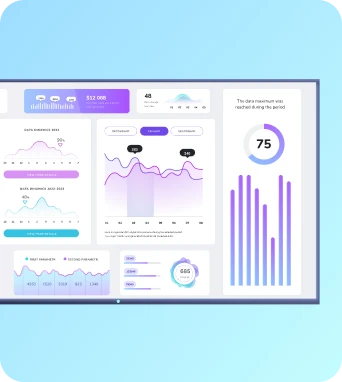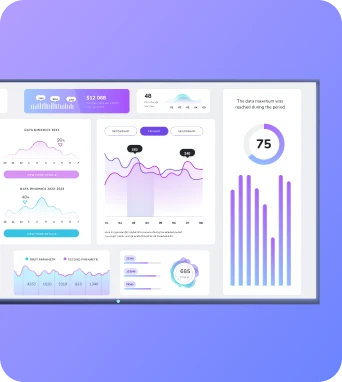AI-driven analytics
AI-driven analytics in digital signage applies machine learning, computer vision and statistical inference to automatically collect and interpret viewer behaviour, dwell time and contextual signals from displays and sensors. The processed insights drive content sequencing, audience measurement, dynamic personalisation and automated optimisation across TV dashboards and workplace displays managed by platforms like Fugo.ai.
What is AI-driven analytics?
AI-driven analytics describes a set of techniques that use machine learning, computer vision and probabilistic modelling to turn raw telemetry from players, cameras, sensors and playback logs into actionable insights for digital signage. In a signage context, those insights include audience counts, dwell-time distributions, content-attractiveness scores, contextual triggers and predicted engagement windows that inform scheduling and creative rotation. For operators of TV dashboards and workplace displays, integrating AI-driven analytics into content workflows enables automated A/B testing, adaptive playlists and compliance monitoring without manual tagging. On platforms such as Fugo.ai, these capabilities are frequently exposed through integrations and APIs that accept event streams, aggregate metrics and return optimised scheduling decisions or performance reports. When implemented thoughtfully, AI-driven analytics becomes a closed-loop system: instrumentation collects signals, models infer patterns, and orchestration layers apply those inferences to deliver more relevant content to audiences while ensuring privacy and operational resilience across distributed signage estates. Model architectures and data pipelines for AI-driven analytics A robust AI-driven analytics solution for signage begins with a carefully designed data pipeline and model architecture that respect latency, privacy and compute constraints typical of distributed display networks. At the edge, lightweight computer vision models—such as quantised variants of YOLO or MobileNet architectures optimised with TensorRT or OpenVINO—perform inference on player-attached cameras to generate anonymised metadata like bounding-box counts, zone heatmaps and coarse age/gender estimations. Those edge outputs are then batched or streamed through secure channels to a central ingestion layer using protocols appropriate for the estate, for example MQTT for constrained devices or Kafka for higher throughput. The ingestion layer normalises telemetry into protobuf or JSON schema, tags it with device and playlist identifiers, and persists it in time-series and object stores that feed training and real-time scoring components. In the cloud or on hybrid clusters, ensemble pipelines combine streaming feature transforms with temporal models to produce engagement metrics and predictions. For instance, a pipeline might fuse edge-sent event counts, player-side playback logs and calendar metadata to feed a recurrent neural network or gradient-boosted trees trained to predict minute-level engagement probability. Inline example: a model consuming features {viewer_count_1min, playhead_position, ambient_light, weekday_flag} can output an engagement_score that the orchestration engine uses to decide whether to extend an ad break or trigger a different creative. Downstream, batch analytics compute long-term KPIs such as content lift and per-location conversion proxies, while feedback loops retrain models on labelled outcomes. Implementations must incorporate differential privacy, data retention policies and schema evolution strategies to remain compliant and maintain operational continuity across heterogeneous player fleets. Deploying AI-driven analytics on signage networks Deploying AI-driven analytics across a signage estate requires operational discipline and integration planning that accounts for hardware diversity, network topology and the chosen orchestration platform. Start by classifying endpoints by capability: high-performance Android players with GPU support can run heavier models and provide richer telemetry, whereas low-power players may only emit playback logs and periodic telemetry. For each class, define an appropriate inference strategy; edge-first inference for privacy-sensitive environments, or hybrid edge-cloud inference where edge extracts features and cloud models perform aggregation and prediction. Integration with management platforms like Fugo.ai typically takes the form of RESTful APIs or webhooks that accept anonymised metrics and return playlist decisions or optimisation directives. For example, a deployment might POST aggregated engagement vectors to a Fugo endpoint which responds with a content-priority score that the local player uses to reshuffle its queue. Common pitfalls during rollout include underestimating network egress, neglecting schema versioning, and failing to test model drift under real-world seasonal behaviour changes. Monitoring should include both systems telemetry—CPU, memory, inference latency—and model performance metrics such as calibration, precision-recall at operating thresholds and temporal stability. Implement automated alerts when data distribution shifts or a sudden drop in engagement is detected, and maintain a canary deployment strategy so model updates are first validated on a subset of locations. Optimisation practices include using quantised models to reduce inference latency, employing asynchronous batching to conserve bandwidth, and implementing reward signals tied to downstream business KPIs so the optimisation loop aligns with real outcomes. In Fugo.ai environments, practical use cases include automated playlist adjustments based on predicted footfall, location-specific creative selection driven by detected audience segment proportions, and cross-site A/B testing orchestrated centrally with per-player roll-back controls. Final Thoughts on AI-driven analytics AI-driven analytics transforms digital signage from a static broadcast medium into an adaptive communication channel that learns from environmental signals and audience behaviour. For TV dashboards and workplace displays, it enables smarter scheduling, improved engagement measurement and evidence-based creative optimisation, while helping network managers justify content decisions with objective metrics. Technical success requires careful pipeline design, privacy-aware edge strategies, continuous monitoring for model drift and tight integration with platforms like Fugo.ai to operationalise insights at scale. CTA: AI-driven analytics matters because it connects data, models and execution so that content on displays becomes contextually relevant and measurably effective. For signage managers and IT teams, adopting these capabilities reduces manual curation, accelerates optimisation cycles and surfaces operational anomalies before they impact audiences. When deployed on a managed platform, the benefits extend beyond engagement metrics to improved uptime, standardised reporting and reproducible experiment workflows that drive better return on creative investment. Learn more about AI-driven analytics – schedule a demo at https://calendly.com/fugo/fugo-digital-signage-software-demo or visit https://www.fugo.ai/.
Model design and data pipelines for AI-driven analytics
Deploying and operating AI-driven analytics across signage networks
Final Thoughts on AI-driven analytics
Keep the learning going...
Advanced signage analytics
Advanced signage analytics is the practice of collecting, correlating and interpreting playback metrics, viewer counts, interaction events and environmental signals from digital displays to quantify engagement, measure campaign effectiveness and drive automated scheduling, content personalisation and device maintenance across signage networks.
Advantech digital signage players
Advantech digital signage players are purpose-built media edge devices and embedded PCs from Advantech designed to run signage applications, decode multimedia, and connect to content management systems. They provide reliable playback, network management interfaces, and hardware acceleration for video, making them suitable for TV dashboards and workplace displays.
AI-driven signage tools
AI-driven signage tools are software systems that apply machine learning and algorithmic decision-making to automate content creation, context-aware scheduling and dynamic display logic for digital signage, TV dashboards and workplace screens, improving relevance, engagement and operational efficiency across signage networks.



